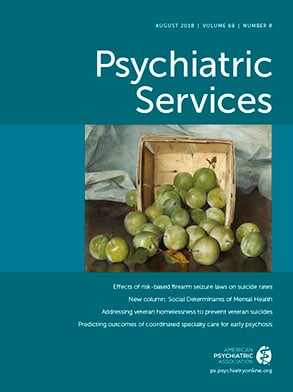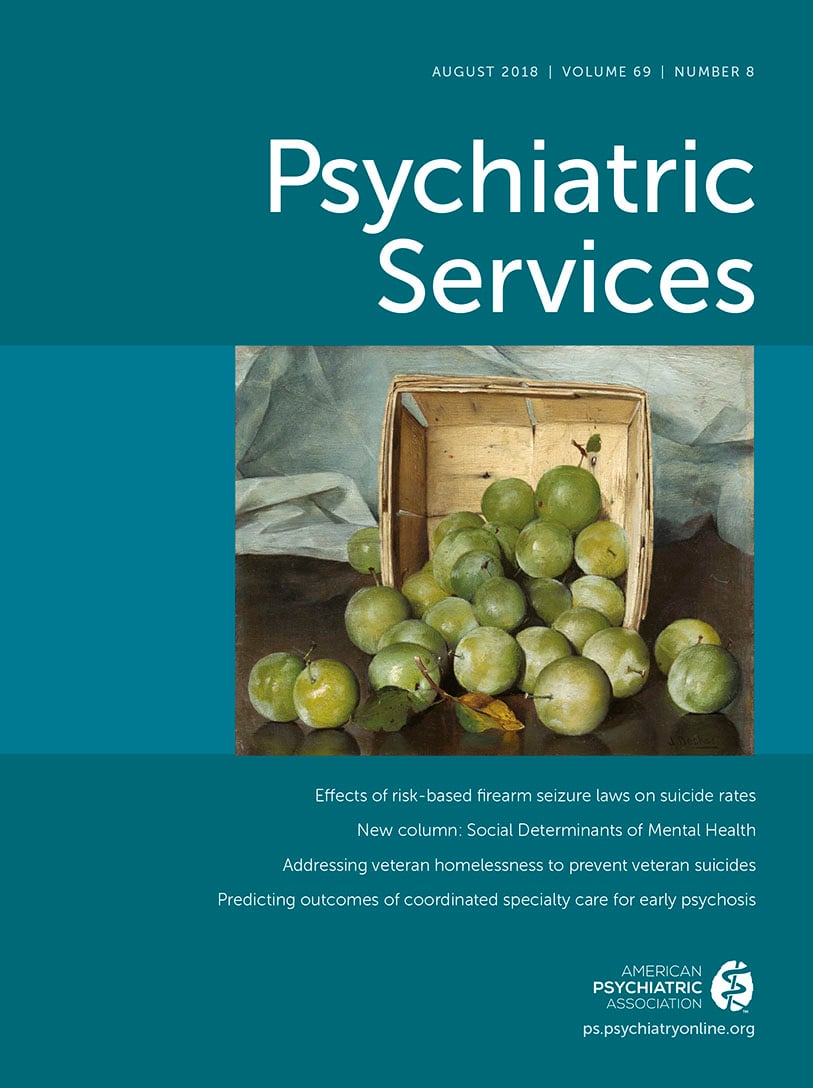People with serious mental illnesses, such as schizophrenia and bipolar disorder, experience very high rates of comorbid substance use and somatic disorders (
1) (e.g., cardiovascular disease and HIV) as well as negative social outcomes, including homelessness, unemployment, and criminal justice involvement (
2). Despite the high need for health care and social services to address these problems, only 65% of adults with serious mental illness received any mental health treatment in the past year (
3). This is in part due to an underresourced U.S. public mental health system, which lacks the funding and providers needed to meet the needs of the 10.4 million American adults with serious mental illness (
3,
4).
Few previous studies have assessed public support for increasing government funding of mental health services. In 2002, McSween (
5) found that 50% of respondents in the nationally representative General Social Survey supported increasing government funding for mental health. Two subsequent national surveys in 2013 and 2014 found that 59% of Americans would like to see more government spending on mental health treatment (
6,
7). Most recently, McGinty et al. (
8) assessed willingness to pay taxes to improve the mental health system in a nationally representative sample of U.S. adults in 2017. Forty-seven percent of respondents were willing to pay any additional taxes, and 42% were willing to pay an additional $50 per year to improve the U.S. mental health system.
Although these four studies show moderate levels of support for increasing funding for mental health services generally, they did not assess any public support for funding of social services, such as supportive housing and employment, which could benefit many individuals with serious mental illness. Also missing is information on the public’s willingness to invest in services for people with serious mental illness in particular. Because stigma varies across mental health diagnoses (
9), support for policies benefiting individuals with serious mental illness may be different than levels of support for policies benefiting individuals with more common diagnoses, such as anxiety.
Understanding Americans’ willingness to pay additional taxes for improving services is especially important given that the majority of health and social services for individuals with serious mental illness are publicly funded. Because policies with high public support are likely to be the most politically viable (
10), it is important to understand the factors associated with the public’s support for increased investment in services for individuals with serious mental illness. We conducted a national survey assessing Americans’ willingness to pay an additional $50 in taxes to improve health care and social services, respectively, for individuals with serious mental illness. In addition, we examined how demographic characteristics and attitudes toward individuals with serious mental illness correlated with Americans’ willingness to pay additional taxes to improve services for this group.
Methods
We conducted an online survey using GfK KnowledgePanel, a nationally representative panel of 55,000 U.S. adults ages 18 and older. Participants were recruited from an address-based sampling frame of 97% of U.S. residences, including cell-phone-only and non-Internet households (GfK provided computer and Internet access when necessary). A simple random sample of 1,738 respondents was drawn from the 55,000-member panel and contacted by e-mail with an invitation to complete the survey. Nonresponders were contacted up to six times with e-mail reminders to complete the survey. The topic of the survey was not disclosed to respondents before the survey was administered. The survey was fielded during November 16–26, 2017, and it was completed by 1,010 respondents (completion rate=59%).
Respondents were asked two dichotomous questions about their willingness to pay: “Would you be willing to pay $50 in additional taxes to improve health-care services for people with serious mental illness in the United States?” and “Would you be willing to pay $50 in additional taxes to improve social services, like programs to help with housing and employment, for people with serious mental illness in the United States?” We measured attitudes toward people with serious mental illness by using a feeling thermometer. Respondents provided a rating from 0 to 100 in response to the question “On a scale from 0–100, where 0=extremely warm, 50=neutral, and 100=extremely cold, how warmly (or coldly) do you feel toward people with mental illness?” For analysis, we collapsed this scale into tertiles to create three stigma groups: low stigma (0–32), medium stigma (33–66), and high stigma (67–100).
Order of the three survey items was randomized. GfK provided respondents’ demographic information, including gender, age, race-ethnicity, education, household income, employment status, region, and political party affiliation. GfK also provided survey weights, which we incorporated into all analyses to adjust the sample for known selection deviations and survey nonresponse, so that the resulting estimates were representative of the U.S. population. [A comparison between the demographic characteristics of the survey sample and the U.S. population is available as an online supplement.]
We used logistic regression to measure the relationship among demographic characteristics, attitudes toward individuals with serious mental illness, and willingness to pay $50 in additional taxes to support improving health care and social services for individuals with serious mental illness. We then transformed regression results into predicted probabilities. We performed analysis by using Stata, version 15. This study was determined to be exempt by the Johns Hopkins Bloomberg School of Public Health Institutional Review Board.
Results
Sixty percent (N=1,010) of respondents expressed willingness to pay $50 in additional taxes to improve health care services (95% confidence interval [CI]=56.7–63.0), and 58% (N=1,010) expressed willingness to pay $50 in additional taxes to improve social services for individuals with serious mental illness (CI=54.8–61.2). Willingness to pay for improved health care services was significantly higher among women (predicted probability=.64) compared with men (probability=.56) (
Table 1). Higher probability of willingness to pay for health care services was reported for those with a household income $75,000 per year or more (probability=.64) relative to those with a household income less than $25,000 per year (probability=.51).
Relative to Republicans, Independents and Democrats were significantly more willing to pay for improving health care services (probability=.48, .59, and .69, respectively) and social services (.45, .55, and .71, respectively). Individuals with high and medium stigma scores had significantly lower probabilities of willingness to pay additional taxes for improving health care and social services relative to those with low stigma scores (health care services: .25, .57, and .70, respectively; social services: .24 .54, and .70, respectively).
Discussion
Our results indicate that a majority of Americans are willing to pay additional taxes to improve both health care and social services for individuals with serious mental illness. The poor health and social outcomes associated with serious mental illness impose significant costs on U.S. society. Health-care expenses, lost earnings, and disability benefits total $317 billion, even before indirect costs related to health conditions, homelessness, and incarceration are accounted for (
11). The results of this study suggest that the majority of Americans support increasing investment in services that could improve health and well-being for this population and potentially decrease societal costs in the long run.
Consistent with previous literature, we found that more negative attitudes toward people with serious mental illness were related to lower willingness to invest in services benefiting this group (
7). Although this finding is only correlational, it suggests that stigma reduction may be an important component of efforts to increase the public’s willingness to invest in improving the mental health system. Investing in better health care and social services could in itself be a stigma-reduction strategy, by helping to change the public’s views of what it means to have serious mental illness. Exposure, through media depictions and in the community, to people with serious mental illness experiencing successful treatment and recovery has the potential to decrease the public’s stigmatizing attitudes toward people in this group (
12).
Our findings contrast with recent federal policy efforts to reduce public investments in vulnerable populations. Recently proposed health care reforms—repeal of the Affordable Care Act and introduction of the American Health Care Act and Better Care Reconciliation Act—were unpopular among the American public. Consistent with our findings showing that most Americans are willing to invest additional resources in services for people with serious mental illness, polling on potential provisions of these acts showed that the majority of Americans were opposed to removing protections for preexisting conditions, eliminating required coverage of essential health benefits, and reducing or limiting federal funding for Medicaid (
13). Medicaid is especially important for individuals with serious mental illness, because it is the primary insurer for this population and covers both health care and social services, including long-term services and supports and psychosocial rehabilitation.
Two highly publicized mass shootings, one on October 1, 2017, at an outdoor concert in Las Vegas and one on November 5, 2017, at a church in Sutherland Springs, Texas, took place in the months before this survey was fielded. Despite the evidence that most people with serious mental illness are never violent toward others and that most interpersonal violence in the United States is not attributable to mental illness (
14), these and other shootings have fostered an ongoing national conversation on the relationship between serious mental illness and violence. Thus, linking serious mental illness with violence might have driven some respondents’ support for increasing investment in health care and social services for this group, with the idea that such services might help to prevent violent behavior. A prior experimental study found that relative to a control arm, exposure to a brief written narrative linking mental illness with violence increased Americans’ willingness to pay additional taxes to improve mental health services (
8).
Willingness to pay for health care services was related to household income. Individuals with higher income levels may have higher willingness to pay, given that the additional tax is a proportionally smaller amount relative to those at lower income levels. Willingness to pay for both services was related to political party affiliation and to negative attitudes toward people with serious mental illness. Differences by political party affiliation were likely due to differing attitudes toward the role of government and taxes in general. Republicans typically favor a limited government role, and Democrats tend to be more willing to invest in government programs. These findings are consistent with previous literature (
5,
7).
Results presented here should be viewed in light of the study’s limitations. Survey respondents might not have precisely understood the distinction between health care and social services for serious mental illness. We attempted to mitigate this issue by providing specific examples of social services (programs to help with housing and employment) in the survey question. Willingness to pay additional taxes was assessed at only the $50 amount, although this increase might not be the correct amount needed to meaningfully improve services.
Additionally, willingness-to-pay measures focus respondents’ attention only on the options presented. Willingness to pay may have been lower if different service options or populations had been presented. Willingness to pay also might lower when tied to actual (rather than hypothetical) payment (
15). Finally, online surveys can be at risk of sampling biases, although GfK minimizes this risk by using probability-based sampling frames and providing Internet access when necessary.
Conclusions
In contrast to ongoing efforts at the U.S. federal level to cut public funding of services to vulnerable populations, our study found that a majority of Americans are willing to pay $50 in additional taxes to improve both health care and social services for individuals with serious mental illness.

